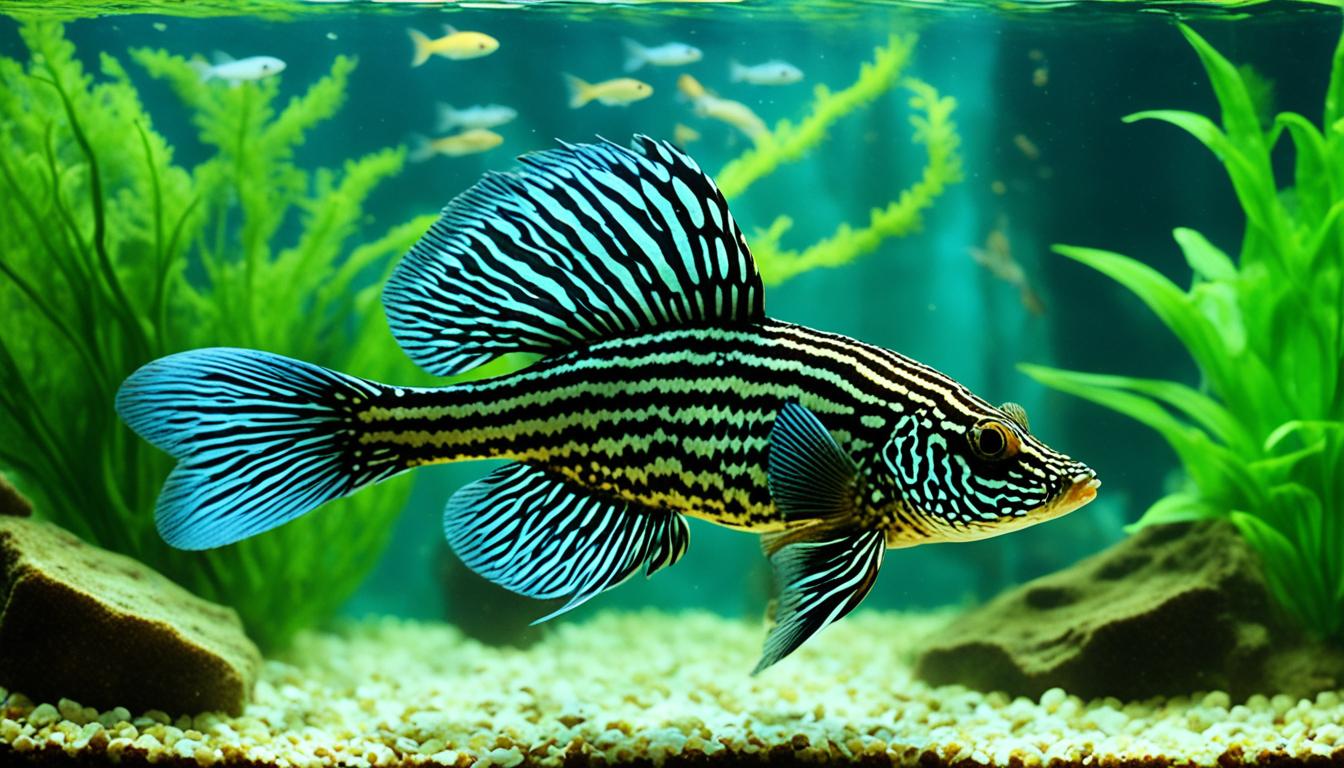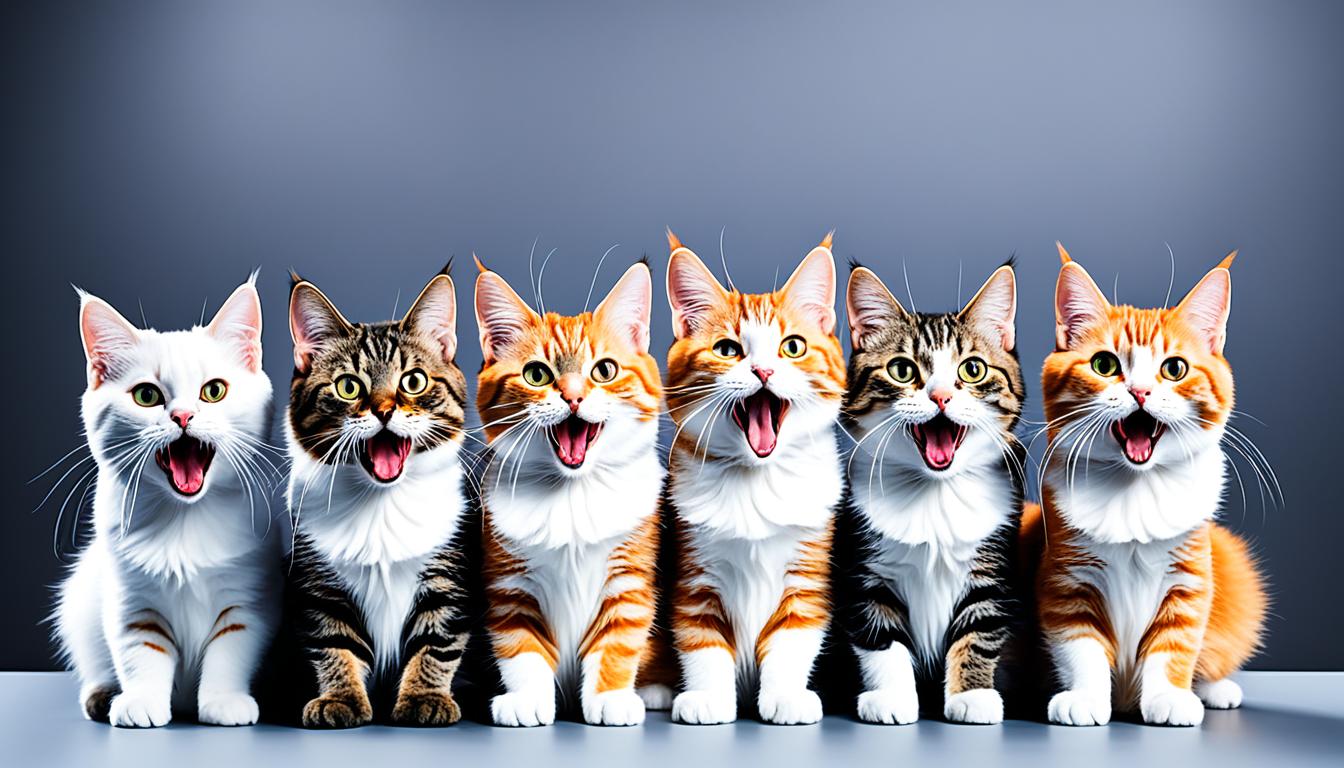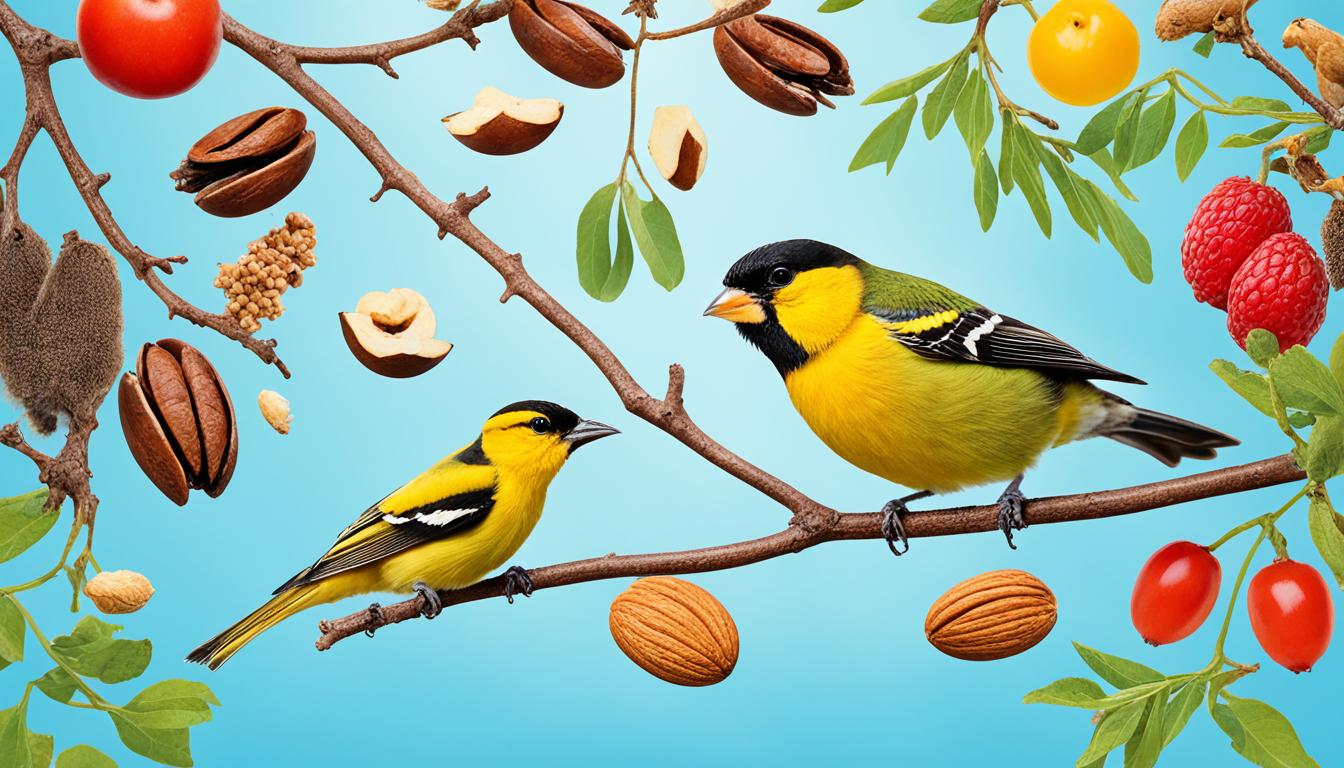Did you know that the average lifespan of a Common Pleco, a popular freshwater fish, is between 10 and 15 years? That’s longer than many other tropical fish species! Despite their easy care reputation, there is a lot of misinformation about Plecos online. In this article, we will provide accurate information about the lifespan of Common Plecos and their care requirements. Whether you’re a current Pleco owner or considering adding one to your aquarium, understanding their lifespan is essential for providing them with the best possible care.
Key Takeaways:
- The average lifespan of a Common Pleco is between 10 and 15 years.
- Plecos require specific care and tank conditions to thrive.
- A balanced diet of vegetables and protein-based foods is vital for their health.
- Common Plecos are nocturnal and prefer to rest and hide during the day.
- Choosing suitable tank mates for Common Plecos is crucial to avoid aggression.
Species Summary
The Common Pleco, scientifically known as Hypostomus plecostomus, is a staple in freshwater aquariums. It belongs to the Loricariidae family of armored catfish species and is native to South America. However, it has also become an invasive species in some regions due to release by pet owners.
The Common Pleco is a popular choice among aquarium enthusiasts due to its unique appearance and beneficial algae-eating habits. Its adaptability to various water conditions makes it suitable for both beginner and experienced hobbyists.
Key Features:
- Belongs to the Loricariidae family of armored catfish species
- Scientific name: Hypostomus plecostomus
- Native to South America
- Has become an invasive species in some regions
- Adaptable to various water conditions
- Well-known for its algae-eating habits
The Common Pleco’s ability to control algae growth naturally makes it a valuable addition to any freshwater aquarium. Its unique appearance and peaceful temperament make it a captivating centerpiece, complementing the overall aesthetics of the tank.
Next, let’s explore the average lifespan of the Common Pleco and the factors that contribute to their longevity.
Common Pleco Lifespan
In ideal conditions, the Common Pleco can live between 10 and 15 years. However, the lifespan can vary depending on the quality of care provided. The Common Pleco has a longer life expectancy compared to many other tropical fish species.
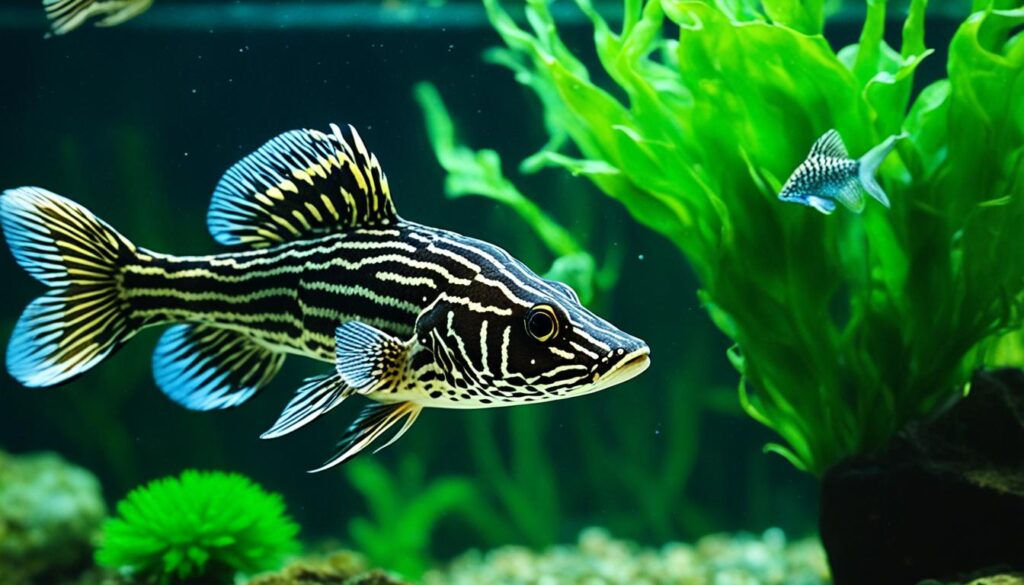
Providing proper care is essential for ensuring the longevity of your Common Pleco. With a lifespan of up to 15 years, these fascinating freshwater fish can be a rewarding addition to your aquarium. By meeting their specific care requirements, you can help your Common Pleco thrive and enjoy their presence for many years to come.
Appearance
The Common Pleco is known for its unique physical characteristics, setting it apart from other freshwater fish.
Firstly, Common Plecos have a signature shape with an underturned mouth, flat belly, and expansive fins. These features contribute to their distinct appearance and make them easily recognizable in aquariums.
Their brown base color is adorned with small black splotches, creating a net-like effect on their body. This coloration provides excellent camouflage in their natural habitat and adds to their overall appeal.
One remarkable aspect of the Common Pleco is its tough armor plates covering its body. These plates offer protection against potential predators and serve as a defense mechanism in its environment.
Their head is another distinguishing feature, with a sucker mouth allowing them to attach themselves to various surfaces. Additionally, Common Plecos have small beady eyes that complement their overall appearance.
The visual representation below showcases the physical features of the Common Pleco:

| Physical Characteristics | Description |
|---|---|
| Shape | Underturned mouth, flat belly, expansive fins |
| Color | Brown base color with small black splotches |
| Armor plates | Tough plates covering the body for protection |
| Head | Sucker mouth, small beady eyes |
Average Common Pleco Size
When it comes to the size of Common Plecos, it’s important to understand that these fish can grow quite large. On average, fully grown Common Plecos in captivity reach a size of around 15 inches. However, in the wild, they can reach a maximum size of up to 24 inches!
Plecos start off small as juveniles, but they have a steady growth rate that can surprise many aquarium owners. It’s crucial to provide a tank that can accommodate their potential size to ensure their well-being and comfort.
Pleco owners must be prepared for the possibility of their fish reaching the maximum size. A tank that is too small can hinder their growth, cause stress, and potentially lead to health issues. Therefore, it’s recommended to choose a large tank right from the beginning to avoid the need for frequent upgrades.
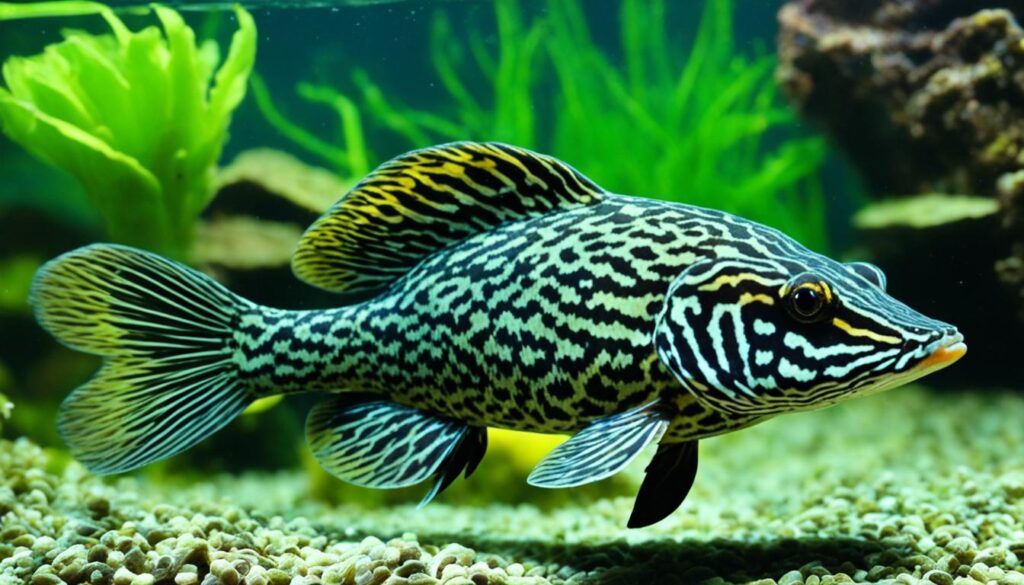
| Size | In Captivity | In The Wild |
|---|---|---|
| Average Size | 15 inches | Up to 24 inches |
Care
Proper care is crucial for the health and well-being of Common Plecos. While they are generally easy to care for, they do have specific requirements that need to be met.
Tank Size
When fully grown, Common Plecos require a spacious tank to thrive. It is recommended to have a tank size of at least 75 to 80 gallons, but larger tanks around 150 gallons are ideal. Providing ample swimming space and territory will help minimize stress and promote their natural behaviors.
Water Parameters
Maintaining suitable water parameters is essential for the long-term health of Common Plecos. The water temperature should be kept between 72°F and 86°F. A neutral pH balance between 6.5 and 7.5 is recommended. Regular testing of water parameters and keeping them stable are crucial to ensure optimal conditions for the fish.
Feeding
Common Plecos are omnivorous and require a balanced diet. Along with algae, which is a common part of their diet, they also need a variety of protein-based foods and vegetables. Livestock or frozen protein snacks such as bloodworms and small crustaceans can be provided. Vegetables like blanched lettuce, zucchini, and peas should also be included. Sinking dry food like algae wafers can be added as well.
Tank Setup
The tank setup plays a crucial role in the well-being of Common Plecos. To replicate their natural habitat, it is advisable to have fine sand substrate, live plants, natural caves, and driftwood in the tank. These elements provide shelter, hiding spots, fiber, and growth surfaces for algae, which is important for their diet. The lighting should be subdued to mimic their nocturnal nature.
Compatibility
When considering tank mates for Common Plecos, it is important to choose fish that are compatible in terms of size and temperament. They can become territorial and aggressive, especially towards fish with bright colors and flowing fins. It is best to keep them alone or with similarly sized and peaceful tank mates to ensure a harmonious environment.
Regular Maintenance
Regular water testing, routine water changes, and proper filtration are essential for maintaining optimal water quality. Common Plecos produce a significant amount of waste, so a powerful filtration system is recommended. Monitoring and maintaining stable water conditions will help prevent stress, disease, and other health issues.
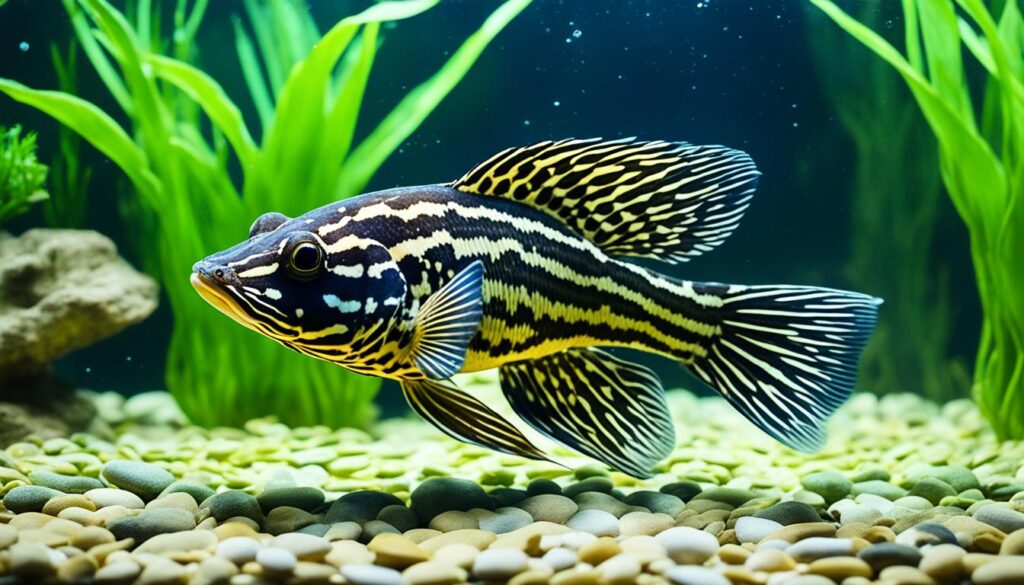
| Aspect | Requirements |
|---|---|
| Tank Size | At least 75 to 80 gallons (larger tanks around 150 gallons ideal) |
| Water Temperature | 72°F to 86°F |
| pH Balance | 6.5 to 7.5 |
| Feeding | Algae, protein-based foods, and vegetables |
| Tank Setup | Fine sand substrate, live plants, natural caves, and driftwood |
| Compatibility | Keep alone or with similarly sized and peaceful tank mates |
| Maintenance | Regular water testing, water changes, and proper filtration |
Setting Up The Rest Of Their Tank
To ensure that your Common Plecos thrive in their tank, it’s crucial to create an environment that closely resembles their natural habitat. This involves careful consideration of tank setup, decor, and filtration. By replicating their natural conditions, you can provide the ideal living space for your Plecos, promoting their well-being and overall health.
Tank Setup
When setting up the tank for your Common Plecos, there are several key elements to keep in mind:
- Substrate: Opt for fine sand substrate, as Common Plecos enjoy sifting through it in search of food.
- Live plants: Introduce live plants to provide shelter for your Plecos, recreating their natural hiding spots.
- Natural caves: Incorporate natural cave structures, such as rocks or driftwood, which serve as hiding places and territorial boundaries for your Plecos.
- Driftwood: Include driftwood in the tank as it not only provides fiber for their diet but also promotes the growth of beneficial algae, which Plecos feed on.
Decor
Creating a visually appealing tank decor is not only aesthetically pleasing but also enriches the environment for your Common Plecos. Consider these decor options:
- Aquarium safe decorations: Choose decorations that are specifically designed for aquariums, ensuring they do not release harmful substances into the water.
- Natural aesthetics: Mimic their natural habitat by incorporating objects such as rocks, driftwood, and live plants to create a visually stunning aquascape.
Filtration
“A powerful filtration system is essential for maintaining a clean and healthy environment for your Common Plecos.”
Given their waste production, Plecos require a robust filtration system to effectively remove impurities and maintain optimal water quality. Consider investing in a filter that can handle the waste output of your Plecos, ensuring a clean and well-oxygenated environment for them to thrive.
To summarize, when setting up the tank for your Common Plecos, focus on recreating their natural habitat with fine sand substrate, live plants, natural caves, and driftwood. Additionally, ensure the tank decor is visually appealing and aquarium safe. Finally, invest in a powerful filtration system to maintain clean and healthy water conditions for your Plecos.

Common Potential Diseases
Plecos can be susceptible to various diseases that can affect their overall health and well-being. It is important for aquarists to be aware of these common diseases and take preventive measures to ensure the long-term health of their Common Plecos.
Common Pleco Diseases
Below are some of the most common diseases that can affect Common Plecos:
- Ich: Also known as white spot disease, ich is caused by the parasite Ichthyophthirius multifiliis. It manifests as white spots on the fish’s body, fins, and gills.
- Dropsy: Dropsy is a symptom of an underlying condition rather than a specific disease. It is characterized by a swollen abdomen, pineconing of scales, and overall lethargy.
- Bacterial infections: Bacterial infections can affect the fish’s skin, fins, and internal organs. Common symptoms include open sores, fin rot, and labored breathing.
- Fungal infections: Fungal infections often occur as a secondary infection in fish with weakened immune systems. They are characterized by white or gray cotton-like growth on the fish’s body or fins.
Prevention and Maintenance
Proper prevention and maintenance practices can significantly reduce the risk of disease outbreaks in Common Plecos. Here are some essential steps to follow:
- Regular water testing: Monitor the water quality parameters such as temperature, pH, ammonia, nitrite, and nitrate levels to ensure they are within the appropriate range for Common Plecos.
- Weekly water changes: Perform regular partial water changes of about 25-30% every week. This helps maintain stable water conditions and removes accumulated toxins and waste products.
- Quarantine: Introduce new fish to a quarantine tank before adding them to the main aquarium. This helps prevent the spread of diseases to the existing fish population.
- Appropriate treatment: If a disease is detected, it is crucial to promptly isolate the affected fish and provide the appropriate treatment. Consult a veterinarian or a knowledgeable fish expert for guidance.
By implementing these preventive measures and maintaining optimal water conditions, aquarists can create a healthy and disease-free environment for their Common Plecos.
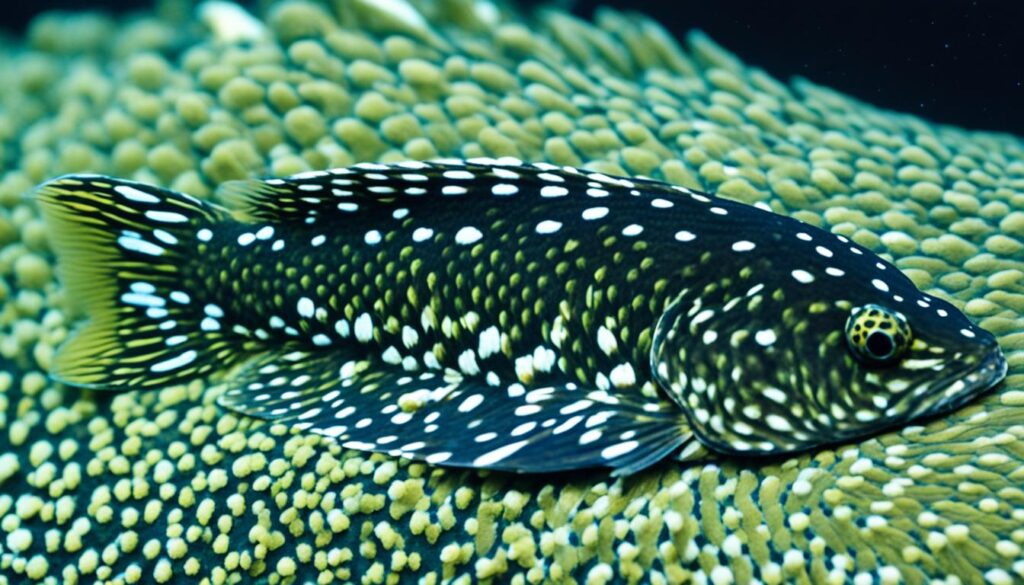
Food & Diet
The diet of Common Plecos is essential for their overall health and well-being. While they have a natural inclination to eat algae, it is crucial to provide them with a balanced diet that incorporates other essential nutrients.
Common Plecos are omnivores, meaning they eat both plant-based and protein-based foods. A varied diet not only ensures their nutritional needs are met but also promotes their natural behaviors.
Vegetables: Include a variety of vegetables in their diet to provide essential vitamins and fiber. Some suitable vegetables for Common Plecos include blanched lettuce, zucchini, and peas.
Protein snacks: Live or frozen protein snacks should be included in the diet to provide necessary protein and promote healthy growth. Bloodworms and small crustaceans are excellent choices for protein-based snacks.
Feeding Frequency and Sinking Dry Food
Common Plecos are most active during the night, making it best to feed them after the lights go off. This way, they can naturally graze on their food during their active hours.
In addition to fresh vegetables and protein snacks, sinking dry food like algae wafers can be provided. These wafers are specifically formulated for bottom-dwelling fish like Common Plecos and contain a balanced combination of nutrients.
It is important to note that overfeeding can lead to obesity and poor water quality. Feed them moderate amounts of food that they can consume within a few minutes, removing any uneaten food afterward.
“A balanced diet is vital for the health and longevity of Common Plecos. Providing a variety of vegetables and protein-based foods ensures they receive all the necessary nutrients.”
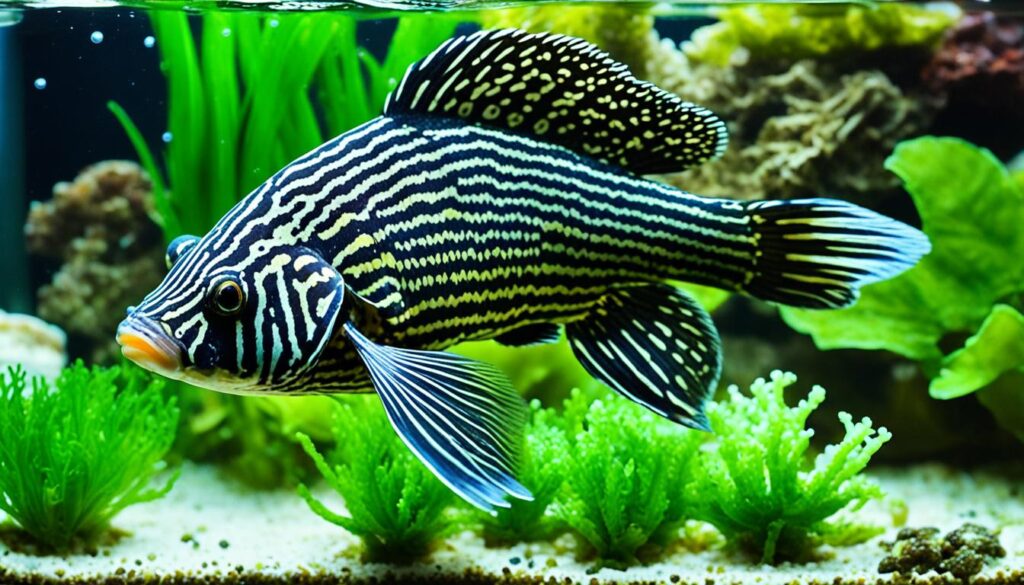
Common Pleco Diet Recommendations
| Food Type | Examples |
|---|---|
| Vegetables | Blanched lettuce, zucchini, peas |
| Protein Snacks | Bloodworms, small crustaceans |
| Sinking Dry Food | Algae wafers, specifically formulated for bottom-dwelling fish |
Behavior & Temperament
Common Plecos, known scientifically as Hypostomus plecostomus, have distinct behavior and temperament traits. They are primarily nocturnal creatures, preferring to rest and hide during the day. This behavior is influenced by their natural habitat and the need to conserve energy. During nighttime, they become more active, scavenging for food and exploring their surroundings.
As adults, Common Plecos can exhibit territorial behavior. They may become territorial and aggressive, especially towards fish with bright colors and flowing fins. This behavior is more pronounced in cramped or small tanks where territory is limited. To ensure the well-being of all tank inhabitants, it is best to keep Common Plecos alone or with similarly sized and compatible tank mates.
Pleco Compatibility Chart
| Tank Mate | Compatibility |
|---|---|
| Angelfish | Compatible with caution |
| Discus | Not recommended |
| Tetras | Compatible |
| Gouramis | Compatible |
| Corydoras Catfish | Compatible |
Keep in mind that compatibility can vary depending on the individual fish’s temperament and overall tank conditions. It is always recommended to monitor the interactions between tank mates and make adjustments accordingly.
A peaceful and stress-free environment is essential for the well-being of Common Plecos. Providing ample hiding spots, such as caves or driftwood, can help alleviate territorial conflicts and provide a sense of security for all tank inhabitants. Ensuring a spacious tank with suitable hiding places allows each fish to establish its own territory, reducing the likelihood of aggression.
Understanding the behavior and temperament of Common Plecos is crucial for creating a harmonious and thriving aquatic ecosystem.

Tank Mates
Common Plecos are peaceful fish that generally get along well with others of similar size and temperament. However, it’s important to choose compatible tank mates to ensure a harmonious and stress-free environment for all the fish in the tank. Common Plecos are not suitable for small community tanks or with fish that are targets of aggression.
“When selecting tank mates for Common Plecos, it’s important to consider their size, behavior, and compatibility. This will help minimize conflicts and create a peaceful and thriving aquarium.”
One consideration is to avoid keeping Common Plecos with fish that have flowing fins, such as Angels and Discus. The Plecos may mistake their long fins for food or become territorially aggressive towards them. It’s best to keep them with similarly sized fish that can stand their ground, ensuring a balanced and peaceful coexistence.
Here are some suitable tank mate options for Common Plecos:
- Tetras
- Gouramis
- Rainbowfish
- Corydoras Catfish
- Loaches
- Dwarf Cichlids
- Some larger species of Characins
Remember, it’s crucial to research and consider the specific needs and behaviors of potential tank mates before introducing them to your aquarium. Ensuring a compatible mix of fish will promote a peaceful and thriving aquatic community.
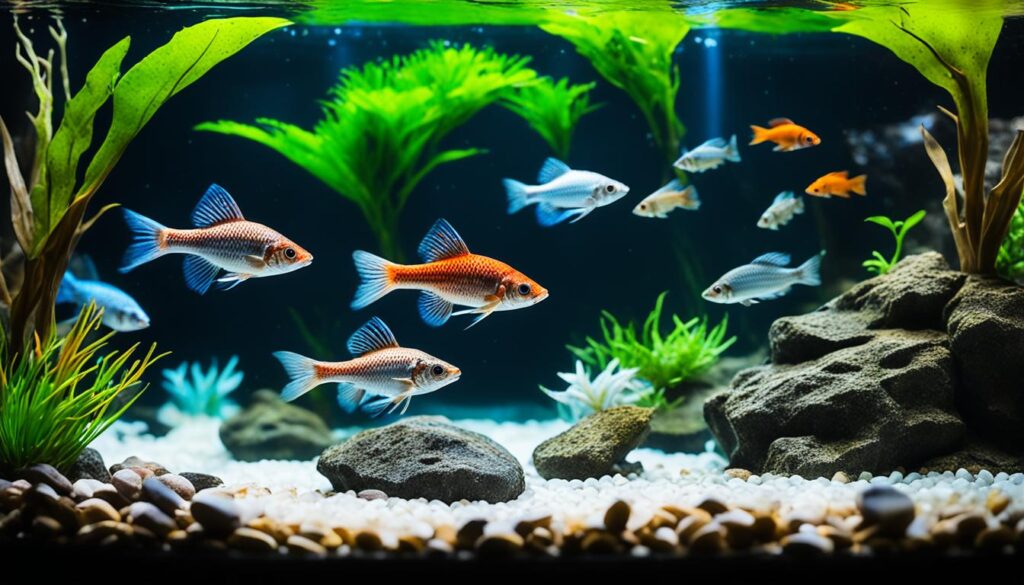
| Tank Mate | Description |
|---|---|
| Tetras | Peaceful and active schooling fish that add color and vibrancy to the tank. |
| Gouramis | Labyrinth fish known for their vibrant colors and peaceful temperament. |
| Rainbowfish | Colorful and active fish that thrive in larger aquariums with open swimming areas. |
| Corydoras Catfish | Sociable bottom-dwelling fish that are compatible with Common Plecos. |
| Loaches | Bottom-dwelling fish known for their scavenging behavior and interesting patterns. |
| Dwarf Cichlids | Small, peaceful cichlids that can coexist with Common Plecos. |
| Some larger species of Characins | Medium to large-sized Characins that can hold their own against a Common Pleco. |
Conclusion
In conclusion, with proper care, a Common Pleco can live an average lifespan of 10 to 15 years. Several factors play a crucial role in ensuring their longevity. Firstly, providing an adequately sized tank is essential. A tank size of at least 75 to 80 gallons when fully grown is recommended, with larger tanks being even better. The water parameters should also be maintained within the appropriate range, with a temperature between 72°F and 86°F and a neutral pH balance between 6.5 and 7.5.
Additionally, choosing suitable tank mates is crucial for the well-being of your Common Pleco. They typically get along well with fish of similar size and temperament, while being less compatible with smaller, more delicate species. Keeping them alone or with similarly sized and compatible tank mates will help reduce stress and aggression.
Lastly, providing a balanced diet is crucial for their health and longevity. While Common Plecos do eat algae, it should not be their sole source of nutrition. A balanced diet that includes a mix of vegetables and protein-based foods is recommended. Vegetables like blanched lettuce, zucchini, and peas can be provided, along with live or frozen protein snacks such as bloodworms and small crustaceans. Sinking dry food like algae wafers can also be included to supplement their diet.
By taking these factors into consideration and providing a healthy and stimulating environment, you can ensure the well-being and longevity of your Common Pleco. With proper care, these fascinating freshwater fish can thrive and bring joy to your aquarium for many years to come.
